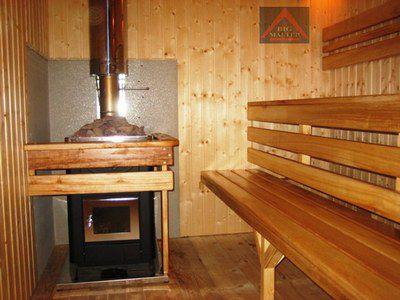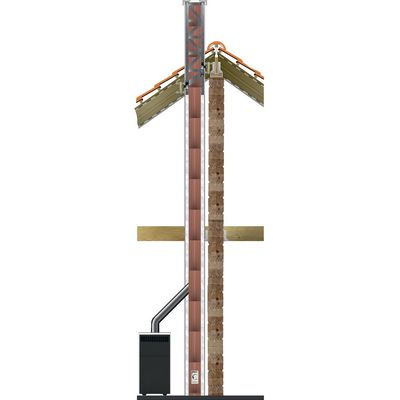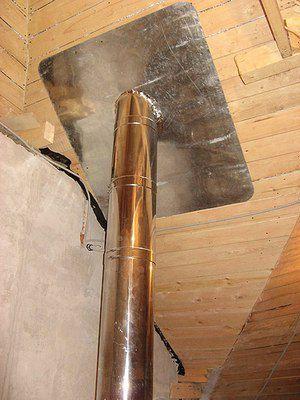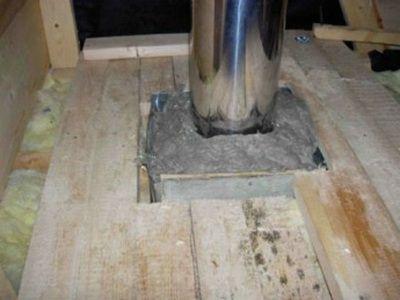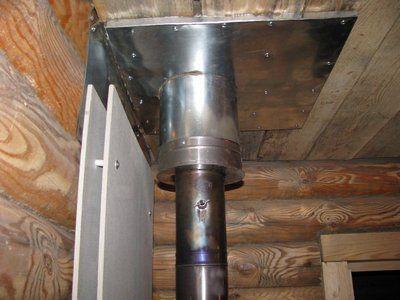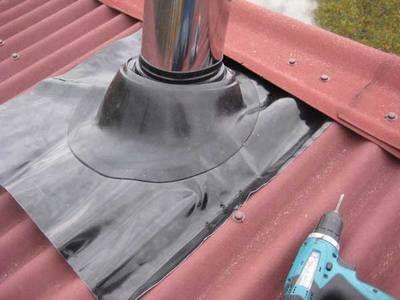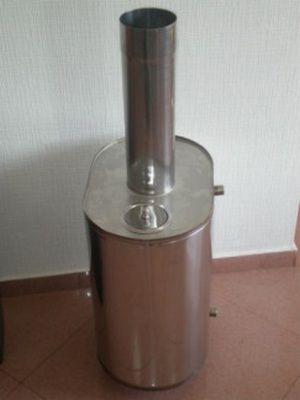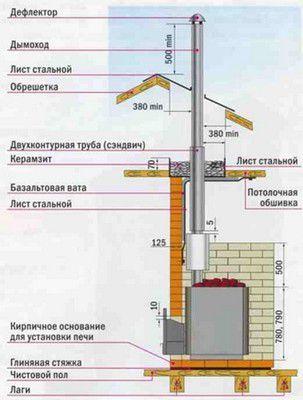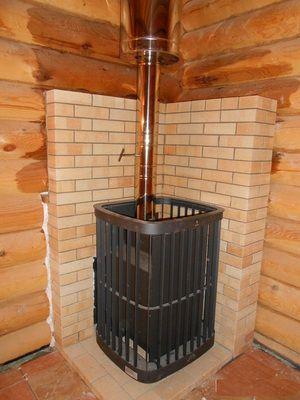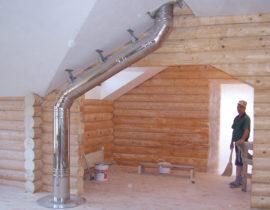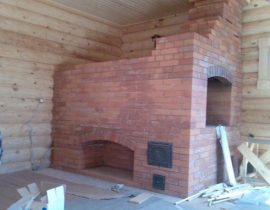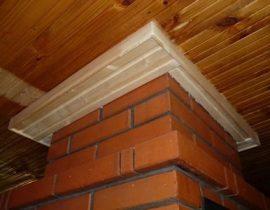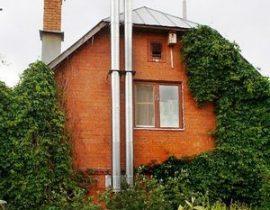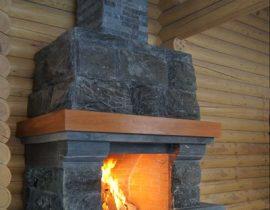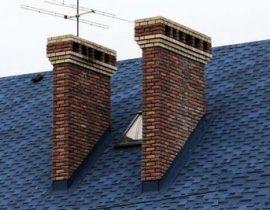No sauna stove can do without the right equipment of all its parts and departments. The device of the chimney in the bath is somewhat different from chimney home heating systems. That's why, in order to achieve the greatest efficiency of the functions of the sauna stove, it is very important to take into account all the nuances of building not only the firebox and heater, but also the chimney.
It should be noted right away that the arrangement of this main bath facility is best done by an experienced master, but if you want to try your hand, you need to carefully understand all the subtleties. Not only how quickly and well the bath room warms up, but also its fire safety depends on a properly arranged chimney.
Content
Types of chimneys
Basically, two types of chimney are used in the construction of a sauna stove — these are indigenous and attached.
- The root chimneys are built separately, next to the stove, and connected to it with a special pipe, which removes smoke into the main channel. This view can even be used for two or three ovens. Naturally, in this case, it must have an appropriate inner diameter, and pipes from different heaters are mounted at different heights.
- The chimney systems with a built-in pipe differ from the indigenous ones in that they are installed directly on the furnace pipe and are brought out into the street through a wall or roof. In bath buildings hosts more often give preference to mounted chimneys.
Chimneys can also be divided on onexternal and internal.
- The first ones are brought out through the wall, and their main part passes along the street, where it is fixed to the wall surface with the help of brackets. But it must be said right away that the external view of the chimney is not suitable for a bath, as it cools faster, no matter how good it is insulated. Namely, for a bath, losing excess heat is an unforgivable luxury.
- Internal chimney systems are installed more often, so it’s worth learning more about them.
One of the main advantagestv vnmorning chimney is its maximum verticality, which contributes to good draft. However, it certainly has its drawbacks:
- for its device in the finished building, you need to cut (punch) holes in the ceiling and roof, and also make reliable waterproofing. Besides, have to work hard to isolate the passage in the ceiling with heat-resistant material;
- a chimney passing outside is much easier to repair than an internal one.
But in spite of possible cons, heat, given away into the room, it is much more important for the bath, so it’s better not to be too lazy and spend it inside so as not to lose the bath heat and not burn excess fuel.
Materials and features of the manufacture of a chimney for a wood-burning stove
The choice of material for the chimney will depend on which stove is installed in the bath.
- A brick oven can be equipped with a chimney, also made of brick, metal or made of asbestos cement.
- The metal version of the stove with an equipped heater is usually supplemented with the same chimney (less often — from asbestos cement). But most often this is — metal pipes with a layer of insulation so called sandwich chimneys.
- Asbestos concrete the option of chimneys, especially for sauna stoves, is undesirable the most important reason — is the porosity of the material. Due to the structural features of asbestos cement, condensate remains on the channel walls for a long time or even absorbed into them, which leads to the destruction of the material. Such a pipe can burst or, if burnt out, even explode. To reduce the formation of condensate, the asbestos-cement pipe is dressed in thermal insulation and lined with brickwork.
From what material neither was chimney pipe completed her the parts must be hermetically connected to each other, and the brickwork must not have gaps. These flaws make it possible to hit inside cold air, which not only reduces traction, but also contributes to the formation of condensate.
diametr trubi must also be calculated correctly — if it is more than necessary, the smoke rising through it will quickly cool down, which also contributes to the formation of condensate.
It is worth paying special attention to the choice of the thickness of the chimney pipe of the bath. The inner version of the chimney must have walls of at least 12 cm, and the outer one - 38—40 cm thick. it's the same will save from rapid cooling meansfrom moisture condensation.
The most important factor for this section of the furnace is the ideal smoothness of the inner walls of the pipe. It will provide the necessary traction, and means, soot will not be deposited on the walls in large quantities. Porous surfaces are capable of accumulating a large amount of burning, from which the chimney have to clean often enough. If a brick chimney pipe is built, then in the attic her rubbed with clay mortar and produce her whitewash. Thanks to these precautions, in the event of cracks in the masonry or other defects, they can be will be immediately detect, black smoke will become seep through the cracks of the grout, and whitewash it well will be it is seen. This is a visual signal of the need for urgent repairs.
Sometimes a combined chimney design is used for bath stoves. In this case, its lower part is built of brick, and the upper part, passing through the floors and roof, is made of a modern sandwich pipe.
This option allows you to arrange neat small passages, which will be easier to arrange with heat-resistant material.
Chimney Safety
It is imperative to ensure high fire safety of the chimney for the bath. To do this, as mentioned above, pay special attention to the tightness of the joints of individual parts of the pipe, as well as to the cutting when the chimney passes through the floors and roof.
In places where the pipe will pass through the ceiling, it is necessary to insulate her from wooden elements with heat-resistant material — it can be asbestos, mineral wool, sand or expanded clay.
- To do this on the ceiling in place chimney passage a metal panel is fixed with a hole through which it will missed pipe.
- From the side of the attic, a kind of box is arranged, which should be 10 meters higher than the attic floor.—15 centimeters. Insulating material is laid or poured into it, which will save wood flooring from high temperatures chimney pipes. The pipe must be least, 25 centimeters from combustible floor materials.
- It is very important to arrange thermally insulating protection not only in the ceiling ceiling, but also on the wooden wall of the bath. Mostly bath buildings are built from pine, and her the wood is quite resinous and can easily overheat and even burn out from the high temperatures of the nearby chimney. Therefore, the wall must be secured with non-combustible material. — it can be special drywall, asbestos, masonry, foil mineral wool or a combination option.
- After passing through the attic, the chimney channel is led through the roof and rises above it by at least one and a half meters.
- Around the chimney, when passing through the roofing, waterproofing is arranged, which will preserve crate roofs from moisture ingress, and means and from the appearance of mold fungus and destruction.
- A special protective fungus is put on top of the pipe head and a spark arrestor is arranged.
water tank
In the chimney system of the bath, erected from metal sandwich tube, sometimes embedded metal tank for heating water, inside which passes bare part chimney.Tanks may have different volume - this is first of all, will depend on the power of the selected furnace.
When choosing this chimney accessory, it is best to pay attention to a stainless steel product that will last a long time. Naturally, you need to focus on the diametertr trthe bottom of the chimney on which the tank will be fixed. It is better to purchase the whole set in a kit so that you do not have to disassemble an already assembled structure.
Branch pipes are provided on the water tank, on which departments are put on. chimney pipes. They must fit tightly with each other, otherwise the thrust will decrease, and carbon monoxide may enter the room.
A metal water tank is also built into the design of a brick chimney. In this case, the hot air from the furnace, passing next to it, heats flooded into the water tank. embedding capacity, you need to provide a place in the wall of the chimney, where there will be a tap and a pipe with a tap to fill the tank.
Scheme of the device of the bath chimney
In this diagram, all the above sections of the chimney system of the sauna stove are clearly visible.
It is worth noting that the sauna stove with its firebox is usually coming out to another room - dressing room. This is provided for to there was no risk of getting burned during washing, and to the attendant had the opportunity to put firewood in the firebox all the time.
Directly in bannom the room has the furnace itself with a metal crate, which encloses red-hot walls and is separated from them by 10—15 centimeters.Pebble stones are placed in this distance, which, when heated, give off heat to the room, and if you want to get steam — they are splashed with ordinary water or infusion of fragrant herbs. Chimney and arranged on German tank in this embodiment, they are also located in the bathhouse.
The figure also it is seenhow the chimney should pass through the floors and roofs and how to ensure the complete safety of its operation.
Based on this scheme, you can easily arrange a chimney yourself, if you strictly follow all the rules, rules, dimensions and volumes insulating materials.
Video: an interesting version of the chimney device in the bath
All works - how by byconstruction of the furnace and according to the device her chimney system - must be carried out with all responsibility and accuracy. It must be remembered that not only the safety of the bath itself, but also the life of the people using it, will depend on the approach to this issue.

